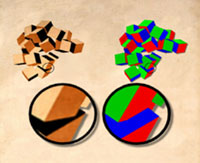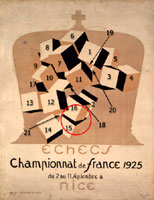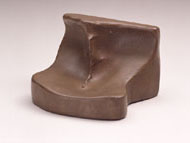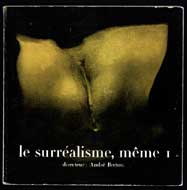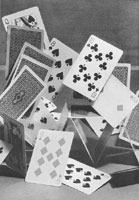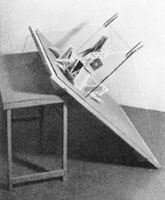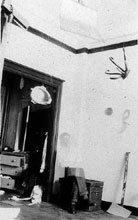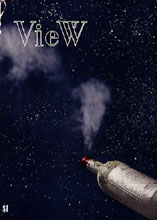Did Duchamp simply use a photograph of "tossed cubes" to create his 1925 Chess Poster? by Rhonda Roland Shearer and Robert Slawinski
|
|||||||||||||||||||||||||||||||||||||||||||||||||
|
Step 4 What Duchamp appears to be doing--hiding embedding points from the eye but not from the mind
Refer to
Figs. 9A and 9B, and to blocks 15 and 16, note the difference
between the treatment of these two blocks in the original chess poster
and our 3D model on the right. Block 15's black top-surface in the
original poster slices into cube 16 in the 3D model to the right. We
learn from comparing Duchamp's poster to our study model that to "hide"
the embedding point of the right cube, Duchamp would only need to extend
the brown square's vertical lines, and to mirror the angle of the square's
top horizontal edge (Fig. 10). Duchamp
repeats this approach throughout the poster, as revealed by our 3D model
and animation sequence. Note cube 4 in Fig. 11,
Cube 4's top square has been extended and this indicates that the top
of cube 4 was originally in front of cube 5 (as in the red/blue/green
model now), whereas the final chess poster indicates that the top of
cube 4 is behind cube 5. Duchamp's creation of ambiguity in indicating
which figure lies in front or in back represents an original variation
upon other optical illusions. Duchamp himself had experimented with
many sensory illusions, such as the convex/concave effect that switches
back and forth in appearance--convex and near, to concave and therefore
farther away. (Duchamp's Female Fig Leaf and the cover of Surréalisme
Même depict the same object.) However, one appears concave,
which is the actual state of Duchamp's object, whereas the convex image
on the Journal cover is a retouched photograph with special lighting
used to create the optical illusion that Duchamp's concave object is
convex (Figs. 12A and B).
We found nothing in the literature of optical illusion that compares with Duchamp's fascinating approach--that is, of actually embedding cubes together, and then altering them in slight but precise and systematic ways, so as to disguise his tamperings and fool our eyes into believing that several cubes are rationally seen behind others instead of in front (see cube 4 and 5), or that the cubes all have 90º angles (see cube 13) or equal straight edges (see cube 8), all in the same perspective view of one photograph. Partial cubes 18, 19, 20, and 21 were probably strategically placed in order to add to the overall instability of the eye and brain as they attempt to decipher the image. In particular, look at cube 8 and compare the angle and shape of the bottom square to the bigger front face. Note that the bottom edge is not parallel to the top edge above in the same square. Cube 8's distortions cannot be attributed to a perspective rendering that matches any of the other cubes, or the overall scene (Fig. 13). As in a baby's game of peek-a-boo, where one comically switches from seeing with eyes to quick concealment (to what the mind can only see in memory or logic) Duchamp forces you to choose. Duchamp has only temporarily hidden the embedding points of the cube from our eyes (as our eyes accept and do not question his alterations of cubes into objects that are, in fact, no longer shaped like cubes). But he has not hidden this from our minds (which can move from intuition to measuring, and can rigorously detect departures of actual forms from ideal cubes).
Duchamp's specific case of the Chess Poster, as its "deception" or optical illusion generally illustrates by direct experience, shows the failure of the retina to reveal reality or truth without the mind. (Philosophers from Helmholz to Thomas Kuhn have often used optical illusions as prototypical proofs for limitation of the eye and mind. In his Structure of Scientific Revolutions (1962), Thomas Kuhn famously refers to the content of revolutions in science, such as the change from a sun-centered solar system to an earth-centered cosmos, as both a mental and visual switch, as in our experience with optical illusions of gestalt figures. Kuhn essentially states that scientists who see only Rabbits before the revolution as in a Duck-Rabbit Gestalt figure will suddenly shift, in eye and mind, to seeing only Ducks in the very same places where only Rabbits were observed before (Fig.14).(5) We believe that the ambiguous cubes in the Chess Poster represent more than Duchamp's specific triumph in first creating a new class of optical illusion in 1925 (the phenomenon that only Penrose and Penrose later named in the 1950s). We suspect that Duchamp also viewed the creation of this poster as an experiment born of his larger and life-long enterprise in exploring "the beauty of the mind" or "grey matter"--especially as in used in chess, vs. the stupidity of using only the eye or "retina," an approach that he often castigated. In addition to his analogy of chess, Duchamp also claimed that allegorical art (that is, art before "retinal" impressionism) had embraced mental beauty in both the artist and the spectator, for he stated that both shared equally in the creative act. In allegorical art, patterns establish a visual language of forms imbued with universal meanings that are mentally encoded by the artist and then, in turn, must be decoded by the spectator's mind and eye--a much different experience, Duchamp insists, than that offered by retinal art and sensations in visual experience alone. Chess itself, by Duchamp's analogy, is similar to allegorical art because pattern emerges from a set of rules (now as moves in the form of combinations, not as a language of visual forms). Instead of being encoded by the artist and then decoded by the spectator alone, as in allegorical art, chess patterns, also meaningless without a knowledge of rules, require the mind to see combinations of moves, including actions of the opponent, who co-creates moves from within the exchanges between players that emerge in the continual application of these rules, and who must also, just as the spectator does in art, also actively decode physical data into mental meaning. Just as the shape of the duck/rabbit captures in time [albeit unstably] both a duck and rabbit, physical reality can only hold one belief at a time. (That is, it can be a duck or rabbit.) Duchamp, we believe, capitalizes on the additional possibilities within optical illusions--for, as representations (as we understand from the 270º of the ambiguous triangle that we recognize as a triangle, but in the physical and Euclidean world would be restricted to 180º) they can be stretched beyond conventional meanings or rules, and even left without full (or even correct) explanation, only to be grasped later by creative acts in spectator's minds. These spectators now see the chess poster as built from cleverly distorted cubes that stay (for a delay) below the threshold of detection in the very same physical positions where a "readymade" unaltered action photograph of falling regular cubes was seen before.
Step 5 Thinking it over: Could it be that Duchamp is just a bad draftsman? Our conventional belief that Duchamp's Chess Poster depicts a set of falling cubes was based upon his claim that he took a photo of falling cubes, and then used the chance positions to create his poster. The geometric shapes that we see in the 1925 poster, perhaps also abetted by the context of chess squares on a chess board, supported a belief that we were looking at multiple cubes, as Duchamp said.(6) To answer a question with a question, we could ask: is it reasonable to believe that Duchamp's lack of talent as a draftsman coincidentally led to a consistent and systemic mistake--in other words, that he drew distorted cubes that all happened to become undistorted real cubes when embedded into each other? It seems to us more reasonable to assume that Duchamp's various distortions--for example his changing a cube to overlapping in back instead of its correct frontal position--were all used to disguise embedded or intersecting planes. In other words, Duchamp challenges us with objects (in this case cubes) that can appear totally random and free in space, but actually are not, if one uses one's mind to see. Shearer and Gould's paper on Duchamp's Three Standard Stoppages (1913-14) presents another case of Duchamp's use of randomness as a decoy that must be questioned and tested before the real story and facts can be seen with the mind. This issue of whether or not a phenomenon is, in fact, random remains an important topic in probability, even today. For example, we believe that a coin toss or a lottery is random. However, we can know with a great degree of certainty that the flip or number is not random if someone wins 100 times in a row. Randomness, in fact, is a matter of testing the facts before you, whether you deal with a coin, a roulette wheel or a photograph of chance "falling cubes."
In "The Secrets
of Trick Photography" by O.R. Croy, we found the following entry
that reminds us of Duchamp's falling cubes (Figs.
15A and 15B). Under the title "The things you don't
see," this section suggests that photo tricks, such as those seen
in fig.15A, create a puzzle "because the way in which they were
taken is not obvious." Croy continues: "It is consequently
good to make puzzling pictures of this kind from time to time because
it is just as much trouble and excellent practice to the photographer
to think out ways and means as it is for the observer to find out how
the work was done."(7)
Fig. 15B exposes the trick of 15A.
Croy mentions that either a sheet of glass or black background with
black thread will work to disguise the supporting structure that creates
the illusion. Duchamp often used trick photography from the 1910s throughout the rest of his life (see Figs. 16A and 16B, two trick photographs. Fig. 16A is from 1917, where Duchamp himself appears as a ghost figure, a typical and popular photo trick of that era. Fig. 16B is the 1945 View cover that Duchamp worked to create trick photographic effects. (Also recall the trick photo showing the Female Fig Leaf of 1950 as a convex figure). |
|||||||||||||||||||||||||||||||||||||||||||||||||
|
Click to see video animation (QT 1.21MB) |
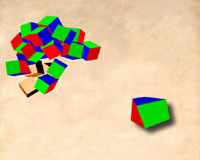 |
|
Figure
17
|
|
Video
animation utilizing irregular polyhedra shapes instead of regular
cubes to match with the "cube-like" shapes in the Chess
Poster
|
Suppose however that Duchamp did not use actual cubes to create his poster, what would be the alternative?
We have a second experiment, seen in Fig. 17's video animation, where we take irregular polyhedra shapes instead of regular cubes, and then match what we see in the poster. (See Fig. 17's video animation that shows the amusing results.)
page 1 2
Notes
![]() 5.
Thomas Kuhn, Structure of Scientific Revolutions (Chicago:
University of Chicago Press, 1962).
5.
Thomas Kuhn, Structure of Scientific Revolutions (Chicago:
University of Chicago Press, 1962).
![]() 6.
Arturo Schwarz, Complete Works of Marcel Duchamp (2000) 708.
6.
Arturo Schwarz, Complete Works of Marcel Duchamp (2000) 708.
![]() 7.
O.R. Croy, The Secrets of Trick Photography (Boston, MA: American
Photographic Publishing Co., 1937) 128.
7.
O.R. Croy, The Secrets of Trick Photography (Boston, MA: American
Photographic Publishing Co., 1937) 128.
Figs.
9B, 10, 11, 12A, 12B, 13, 16A, 16B
©2002 Succession Marcel Duchamp, ARS, N.Y./ADAGP, Paris.
All rights reserved.
